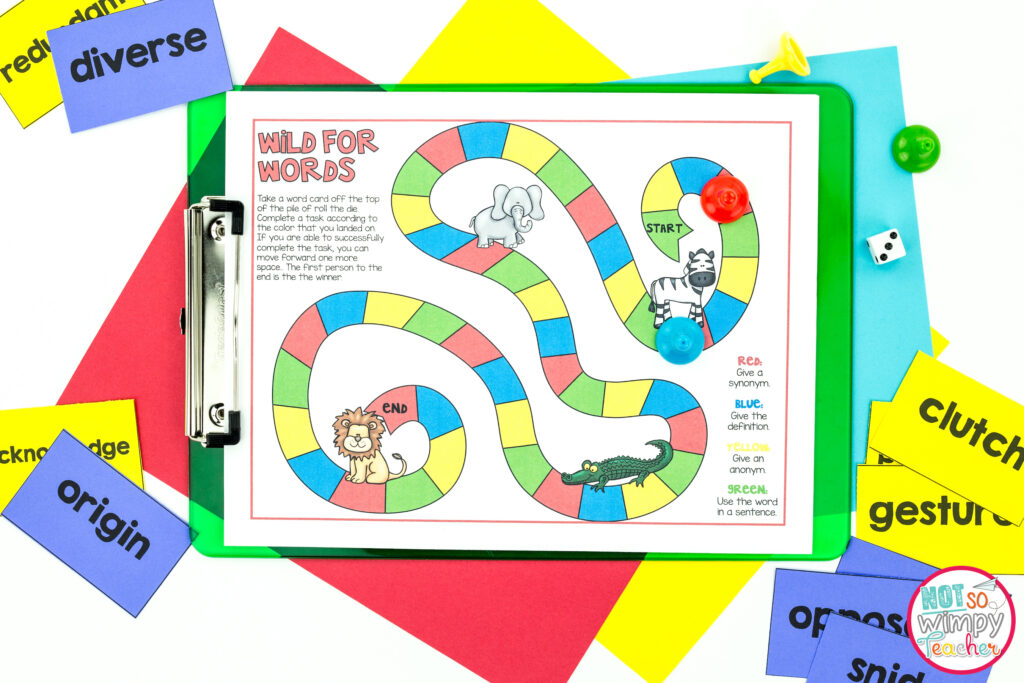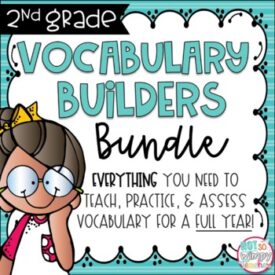
You know vocabulary is an important skill for children to learn. The more robust a student’s vocabulary, the better their reading comprehension. A strong vocabulary also leads to better verbal and writing skills. Luckily you don’t need much time to establish an effective vocabulary routine. You can teach vocabulary in just ten minutes a day.
Teach the right vocabulary words
One of the most important decisions to consider when launching a vocabulary routine is what words you are going to teach. You probably associate vocabulary lessons with your reading curriculum. Or perhaps you draw your vocabulary list from your content areas. Or maybe you even let students pick their own words.
Unfortunately, these words aren’t the best words to focus on in your vocabulary routine. While it may be important for students to understand the meaning of these words in the context of a specific story, or science or social studies lesson, many of these vocabulary words are obscure and students aren’t likely to encounter them repeatedly.
Consider the third grade science term “igneous rock.” Students aren’t likely to regularly see that word in grade level texts. So knowing what “igneous rock” means isn’t going to help them very much with their reading comprehension.
Most of the words that we draw from content areas are tier three words. Instead, your vocabulary routine should focus on tier two words. If you need a quick refresher, here’s a break down of the tiers:
- Tier One: Words that students don’t need to be taught because they already know them when they come to school. Examples: fast, dirty, clock
- Tier Two: High frequency words that students do not already know, but will likely see in grade level text. Examples: coincidence, measure, absurd
- Tier Three: Low-frequency content specific words that pertain to a specific subject. Examples: acronym, binary, isotope
A vocabulary routine that focuses on tier two words helps students increase their vocabulary in a way that positively impacts their reading comprehension, and their verbal and written communication skills.
Provide explicit instruction
When I was in school, vocabulary consisted of copying words out of the dictionary and writing them five times each. It was completely mind-numbing and ineffective. I may have remembered the words for our vocabulary test on Friday, but I didn’t “know” these words. I didn’t recognize them when I encountered them in other contexts.
One year the teacher actually had us select our own vocabulary words from novels we were reading. You can probably guess what happened . . . Everyone chose words they already knew.
Teaching vocabulary requires explicit instruction. We need to take the time to introduce new words to kids and to help them determine the meaning of these words using context clues, prefixes, suffixes, and other strategies.
It’s true that kids do pick up a lot of vocabulary informally through what they read, watch, and hear. But a good vocabulary routine also includes explicit instruction.
A 10 minute vocabulary routine that works

This is a simple 10-minute vocabulary routine that I used in my classroom. I recommend following the same vocabulary routine every week. Keeping activities consistent from week to week helps kids know what to expect. It also saves valuable class time because you only have to teach directions once.
Monday: Introduce New Words
This vocabulary routine starts with introducing five new words every Monday. You will study these words all week long. Try one of the following methods to introduce the words:
- Give students a sentence with the new vocabulary word and ask them to guess what the word means. They will need to use context clues and make inferences to arrive at possible meanings. After taking a few different responses, write the correct definition on the board (or reveal it on your PowerPoint). Take a few minutes to discuss what context clues helped students determine the meaning. This strategy helps you practice several skills at once (context clues, vocabulary, inferences, public speaking).
- Alternatively, you can provide a definition and the part of speech along with the new word. If you give students the definition, you should ask them to use the word in a sentence. This helps students practice grammar skills, like parts of speech, proper verb tense, and constricting sentences. As a class, select one great sentence to record in your vocabulary journal.
Students will record the definition and a sentence for each word in their vocabulary journals every Monday.
Tuesday: Examples & Non-Examples

Tuesday is for practicing synonyms and antonyms. If you teach a lower grade you might instead talk about examples and non-examples. The process of coming up with examples and non-examples helps make new words more concrete for students and provides context for the words.
The key to making Tuesday’s activities an effective part of your vocabulary routine is to spend time talking about why certain words are or are not good examples. Be sure to discuss parts of speech and verb tense. Help students notice that the best synonyms are the same part of speech or tense as the original word. (Don’t you love when you can combine vocabulary and grammar in one lesson?)
Your students might want to debate whether a word is or is not a good example. This debate can make for a lively discussion and help increase their understanding of new vocabulary words. Just be sure to set aside some time to teach students how to have respectful conversations.
Finally, don’t be afraid to throw in some fancy words of your own during your vocabulary conversations. Students will likely remember these “big” words and add them to their vocabulary as well.
Wednesday: “Wow” Words
On Wednesday, take a break from your weekly word list to focus on a “wow word.’ A “wow word” is just a word that has either a prefix or a suffix. But doesn’t “wow” make it sound exciting?
Word study is an important part of your vocabulary routine. It teaches students how to break a word apart into the root and affix. Once they identify both parts of the word, the root and the affix, you will brainstorm other words that have the same root or affix.
When students consider multiple words with the same affix or multiple variations of the same root word, they begin to understand how the affix changes a word. This is a game-changer for their understanding of words and a must-do part of your vocabulary routine.
This process also gives students a helpful strategy to use when they encounter new words.
Thursday: Draw a Picture
By the time Thursday rolls around students have a basic understanding of the vocabulary words’ meanings. So take that understanding a step further by engaging another part of their brains.
Students draw a simple picture or representation of what the word means to them. This helps make connections between a new word and the world. And it gives them a concrete image to associate with the word which aids their memory.
One word of warning though . . . your vocabulary routine should only take ten minutes, fifteen max, each day. You will need to teach your students that these pictures are meant to be simple representations that help them remember the word. They are not meant to be works of art.
Friday: Review

Fridays are for fun. The final day of your vocabulary routine gets students up and moving as they review their vocabulary words. Review is an important part of any learning routine, and movement is a great way to facilitate learning. Here are a few fun Friday review activities:
Vocabulary Games
It’s fun to end the week with a vocabulary game. Students love getting to play while they learn. And the more fun they have, the more engaged they are, which means they are actually learning. Therefore, games are a valuable addition to your vocabulary routine.

Some of my favorites are Trashketball, Pop, and Charades. Learn more about vocabulary games you can play with any vocabulary words.
I love games so much I created a collection of 10 FREE VOCABULARY GAMES for you. Use the button below to download your Free Games!
Vocabulary Social
A vocabulary social is another fun way to review. Every student gets assigned a vocabulary word, and they must become an expert on their word. Then, they have to act as if they are that word and mingle with their classmates.
Students move through the classroom greeting one another as their word.
“Hello Continent, I’m Agreeable. Would you like to have a chat with me?”
“Well hello, Agreeable. I would love to chat with you if you don’t mind coming over here. I’m a large landmass, and I move very slowly.”
”That would be lovely, Continent. I’m happy to move over to your area. Anything you want, really. I aim to please.”
This activity can get pretty silly. But it’s great fun. And it makes a great review.

Ready-to-use vocabulary lessons
Ready to launch a ten minute vocabulary routine of your own? I have made it super easy to do so. My vocabulary bundles for grades 2-5 contain a full year of tier 2 vocabulary words for each grade level.
Each bundle comes with
- 160 Tier 2 vocabulary words
- Daily lessons for teaching vocabulary
- A weekly teacher guide that includes 5 weekly words, definitions, synonyms, antonyms, sentences and parts of speech
- Student vocabulary lists
- Biweekly assessment and answer keys
- Quarterly assessments
- Games
- Student printable
- Detailed directions
- And more!
This bundles has everything you need to make establishing a vocabulary routine easy and effective.
Shop This Post

For more great tips on teaching vocabulary, read about how to differentiate vocabulary instruction, mistakes teachers make when teaching vocabulary, and 10 games you can play with ANY vocabulary words.
Have a Not So Wimpy Day,























 End of Year Carnival Week for grades 2-5!
End of Year Carnival Week for grades 2-5!
Do you find that students right now are needing a level below where they are grade wise due to covid learning? For example, should I use 2nd grade vocabulary bundle for my 3rd graders?
Yes, unfortunately I do find students are at least one grade level behind where they should be. Students need us to start with the basics.
Hi Lisa,
Since Tier 2 words are ones students will see in grade-level texts and standardized tests, we recommend using the bundle for the grade level you teach. Of course, you know your students best. You can preview many of the words used in the product preview in TpT to determine what you think is the best fit.
Do you also require students to spell the vocab words correctly?
Hi Cindy,
Great question! We want the focus to be on the meaning of the word, not the spelling. To help teach students how to spell using patterns and word families, the Spelling Curriculum is a great resource. http://www.notsowimpyteacher.com/spelling